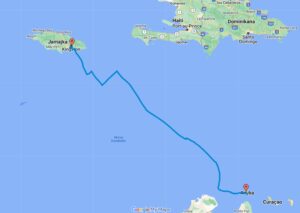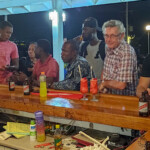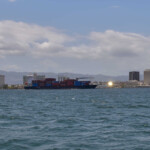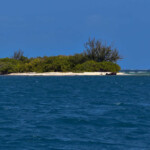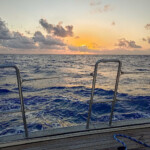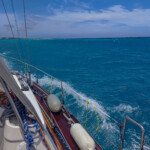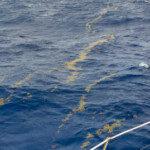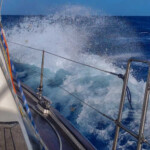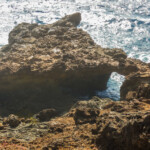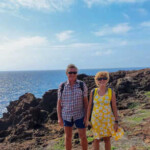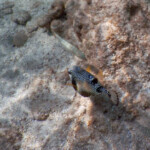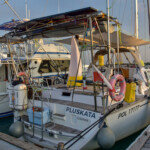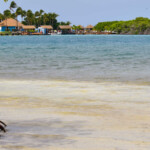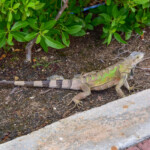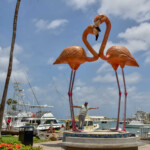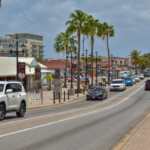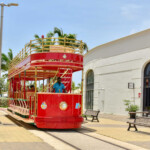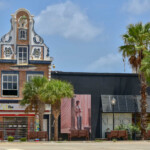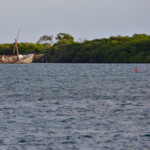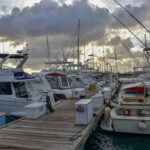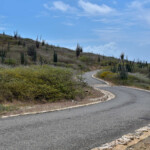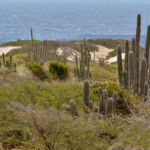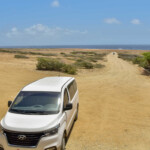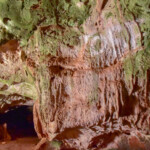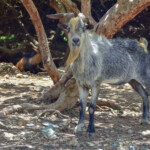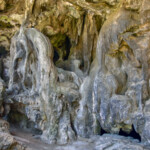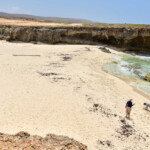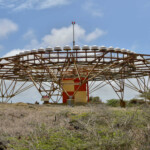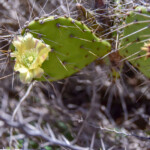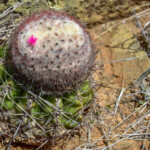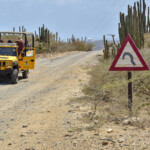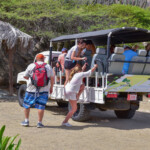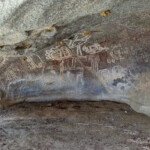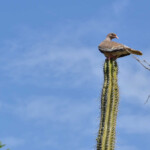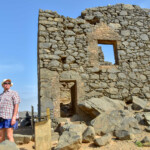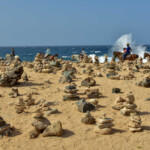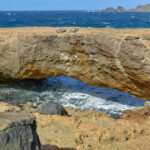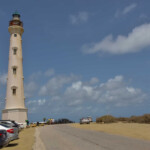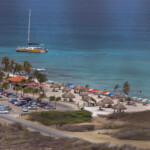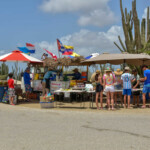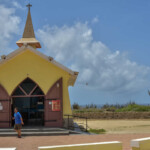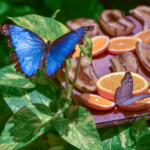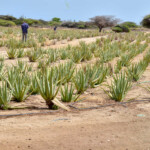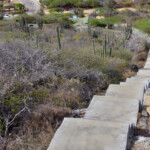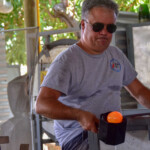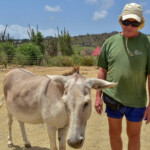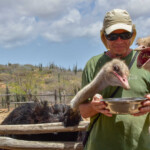Route: Kingston (Jamaica) – Oranjestad (Aruba)
Date: 16-23.05.2024
Miles/hours: 615nm/181h
Check out clearance Jamaica
You must report your intention to leave at the marina office approximately 24 hours in advance. A customs officer comes to the yacht and gives us a “Clearance for steamship”, we fill out the same paper as when entering, but this time when leaving and give it to the official. He warns us about pirates (that’s his duty) and we can set sail.
The sail to Aruba
On Thursday morning, I pay the marina, we go to the swimming pool and sail out at 12:30. We sail through the bay on the fairway for about 3 hours. At the end of the fairway, a large ship hails us and politely asks us to sail more to the right, so it will overtake us. As he passes us, a man from the wheelhouse comes out and waves at us. Nice.
On Saturday morning, we are greeted by dolphins and flying fish. Tomek is experimenting with bleeding the desalination pumps. In the evening, a flying fish enters our cabin through the hatch and swarms around the cabin – finally, Tomek manages to catch it and release it into the water.
Experience with deaeration shows that you need to purchase an additional saltwater pump for continuous operation. After another calculation of the route, it turns out that Pluskata does not sail 20 degrees to the wind, so on Sunday we decide to use the engine. We leave the enlarged mainsail and the engine running. You have to be careful because there is a lot of seaweed on the propeller from time to time.
In the evening I save another flying fish that fell onto the deck.
We are constantly sailing against the wind (about 20kn) and the current (up to 2kn).
Aruba entry check-in
You need to sail to the customs building in Barcadera (be careful, it’s shallow!), dock, go to immigration first, fill out the form on a local computer (you can also do it in advance online: https://edcardaruba.aw/). It is completed separately for each person. With the completed papers, you go to customs – apparently Sailclear works here, but Aruba is not on the list of countries supported by this application. All completed documents are copied, and I am left with the originals – fortunately, there are not many of them, and a QR code is sent by e-mail from Immigrations.
Aruba
Aruba is an autonomous territory belonging to the Kingdom of the Netherlands, with an area of 193 km2 and a population of around 100,000. It is worth adding that these are descendants not only of Spaniards, Dutch and Africans who were brought here to work years ago, but also of the indigenous people – Arawak Indians. This cultural mix led to the creation of the Papiamento language, which is very popular on the island, and which has both European and African roots. The other languages spoken here are Dutch, Spanish and English.
Aruba is a very dry island (even the cacti wither). Approximately 400 mm of rain falls here annually. The Spanish landed on the island in 1499, and in 1636 it was taken over by the Danes, and in 1816 it became part of the Netherlands Antilles. In 1986, it obtained the status of an autonomous country of the Kingdom of the Netherlands.
Marina Varadero
A very nice marina right next to the airport (unfortunately the terminal is on the other side of the airport).
To Oranjestad (the capital of the island) there is bus no. 8 from the marina (3 trips in the morning and 3 in the evening). On foot, it’s about 5 km along the airport (note: you have to go around the fence when entering shallow water). The marina has very good desalinated water – you can drink it straight from the tap – apparently the best in the Caribbean. In a marina restaurant, the waitress brings a glass with each order, fills it with ice water and adds it as soon as you get a little drunk. The pub is called the Fish House and as a daily dish it serves freshly caught fish prepared in the way you choose (fried, baked, boiled, in garlic sauce and many others)
Oranjestad
The capital of the island. A beautiful tourist town with sweet, colorful fairy-tale houses, modern hotels and small Dutch houses in the suburbs. There is a free tourist tram around the city (the entire route takes about 45 minutes, but there is a 15-minute stop along the way). There is also a marina in Oranjestad, but places must be booked well in advance, especially during hurricane season.
Arikok National Park Aruba
National Park covering 20% of the island. Entrance ticket for the whole day costs $20. You can drive there or go on foot. At the Visitors Center you buy entrance tickets and get a map of the park with marked roads and hiking trails. It is worth driving to two caves: Quadirikiri and Fontein, seeing beautiful beaches and a natural bridge (Tripod Bridge), and climbing the second highest mountain in Aruba (Sero Arikok 185m). You can also go hiking – remember to take water and sunglasses.
California Lighthouse
A lighthouse at the northern end of the island. It is 30m high. Admission is $5. You go upstairs via narrow winding stairs. From the top there is a view of the beautiful beaches of Tirera del Sol and the rest of the island. The observation deck is fenced all the way to the top with a mesh – just in case no one falls out. The name of the lighthouse comes from S.S California, which sank before this lighthouse was built.
Alto Vista Chaptel
The Alto Vista Chapel is a small Catholic chapel that stands in the hills above the north shore. In front of it are numerous stalls with souvenirs and a car with drinks (including alcoholic ones). The chapel is painted sandy yellow.
Butterfly Farm
A small garden secured with a net, where thousands of butterflies flutter. There are “feeders” on display to which butterflies eagerly come. They are really beautiful. Employees are happy to answer questions. You can also listen to stories about the life of butterflies. Cocoons of more butterflies can be seen in the cages behind the net. Some have already pupated, but have not yet fully developed their wings. You can enter several times a day with one ticket.
Aruba Aloe Factory Museum and Store
Factory, museum and shop selling aloe products. The factory was established in 1840. He has his own plantation. Here, aloe is suitable for the production of cosmetics after 9 months. The leaves are picked when there is an order from production (this way, aloe in cosmetics is always fresh). There is a free guided tour of the plantation and factory (about 20 minutes).
The lady first tells us how to trim aloe and demonstrates it on an aloe leaf. Then we go to the factory, where you can see the entire production process through the windows, then a short story about the products produced, and finally a visit to the store. Almost every product has a tester. The products are really good. We splurged and bought a large tube of Alhydran Care – a concentrated medical gel-cream for treating and moisturizing sensitive skin immediately after closing the wound. Suitable for post-burn care. Helps prevent scarring and reduces itching. A panacea for almost everything.
Mount Hooiberg
Hooiberg means haystack in Dutch. The mountain has the shape of a cone and rises to a height of 165 meters in the central part of the island. There are approximately 590 steps to the top. It is worth climbing to the top – the view from the top is beautiful. At the top, apart from a beautiful view, there are 2 buildings and a whole lot of antennas. One of the buildings belongs to a radio station, the other to the local telecommunications company SETAR.
The stairs to the top are also used by athletes to practice their fitness. If the weather is good, you can see Venezuela from the top.



